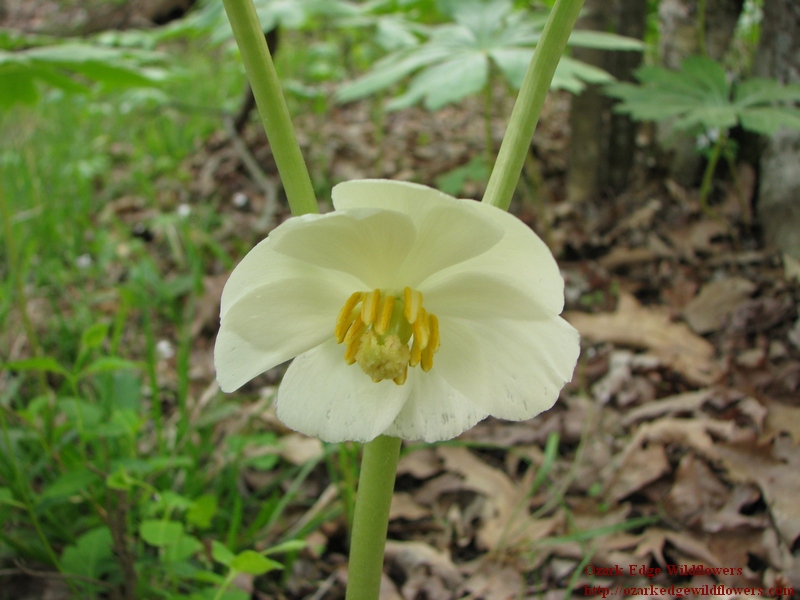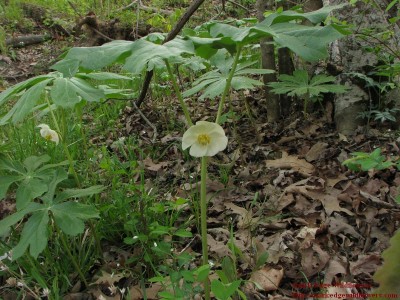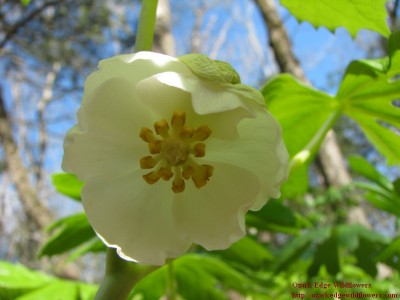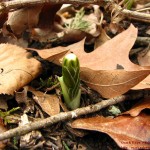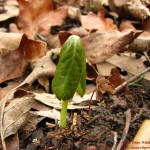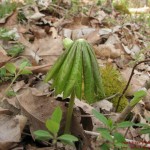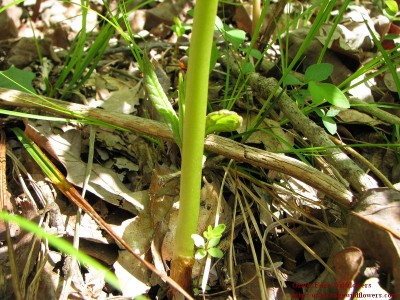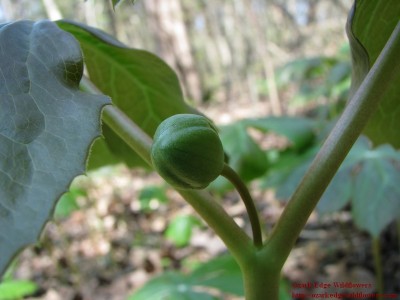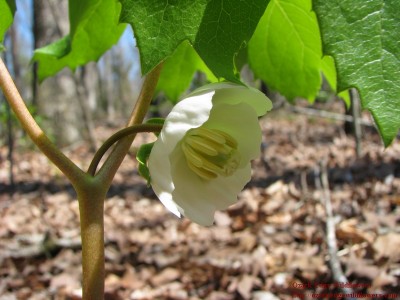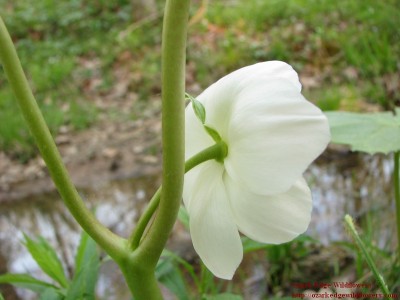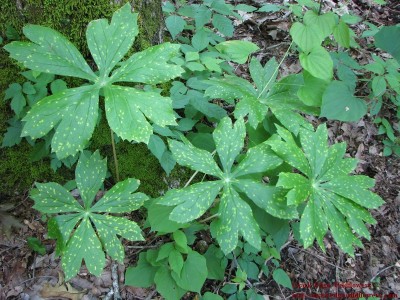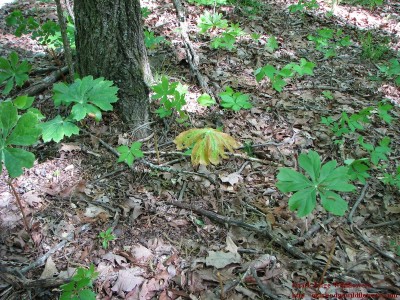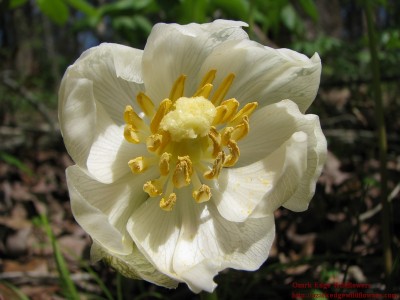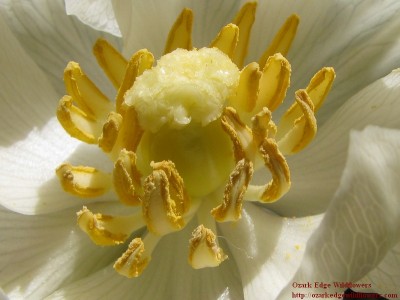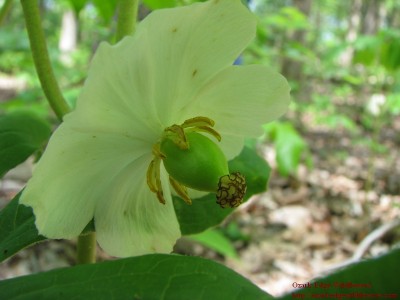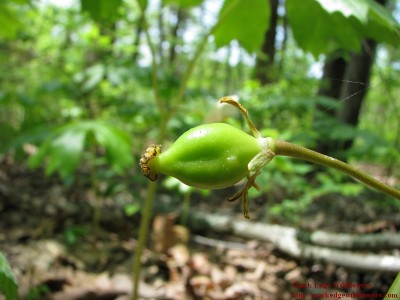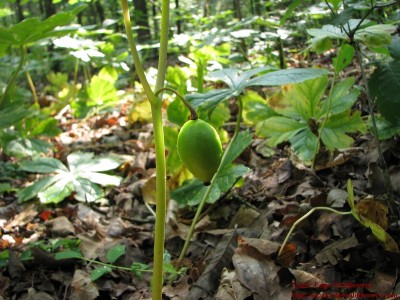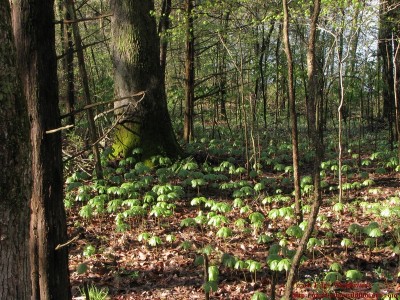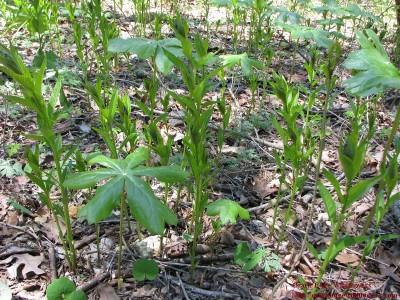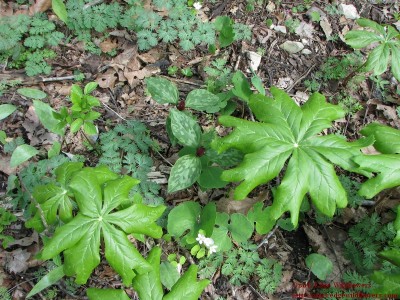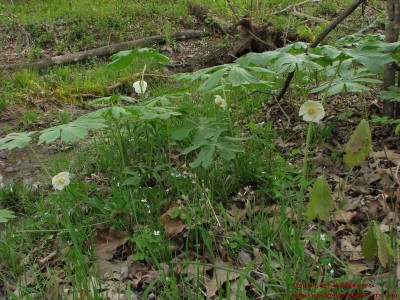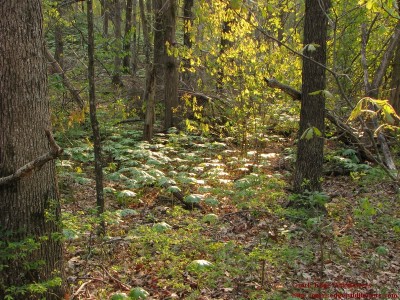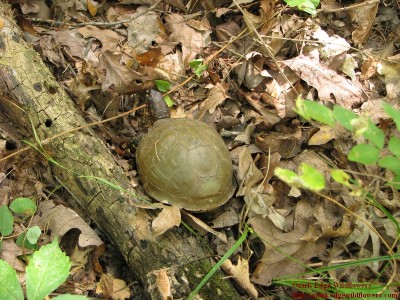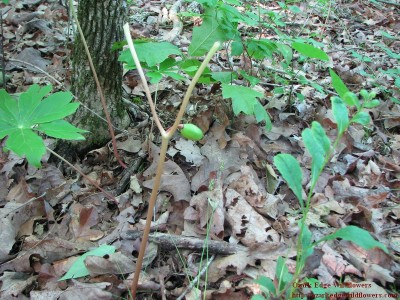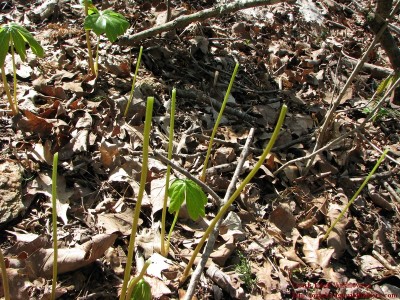Colonies of Podophyllum peltatum form lush green carpets in the woodlands of Ozarkedge. With each huge leaf in close contact with its neighbor, the forest floor can be completely hidden for large stretches. Sometimes they are spaced just enough apart to share the rich earth with a few friends. Either way, their distinctive leaves add a rich texture and drama to the woodlands. You usually have to search for their flowers, which are often hidden underneath the large umbrella leaves. The pretty flowers are worth the search.
Latin Name/Common Name- The scientific name “Podophyllum” is derived from the Greek word, podos, meaning foot, and phyllon, meaning leaf. Peltatum means shield shaped. The most frequently used common name is May apple and refers to the lemon shaped fruit that appears after flowering. Another common name is American mandrake. This is confusing because it is not at all related to the European Mandrake- a plant with purple flowers.
Bloom Color- The flower of Podophyllum peltatum consists of waxy white petals with prominent yellow stamens. The bloom is large, being about 2 inches across. The pretty flower is usually in a nodding position and often hidden underneath the large leaves.
Nodding flower underneath two umbrella like leaves
Macro view of the pretty flower
Description- Podophyllum peltatum is one of the first plants to emerge from the ground in early spring. The leaf is folded around the stalk at first, and then slowly opens like an umbrella as the stalk grows in height.
Newly emerged leaf of May apples from early March to April
The stem is stout, smooth and hairless. It grows up to 2 ft tall. The plants have either one or two leaves. Single leafed plants do not produce a flower. Those with twin leaves have a solitary stem, which divides like the letter “y”. Each leg of the “y” is a long petiole which terminates at the inner margin of a leaf. These twin-leafed plants will produce a single flower arising on a stalk where the stem forks.
Smooth, stout stem is hairless
Flower bud in early April
Single flower arising at the fork of the stem
Back of the flower
Each palmate leaf has 5-9 lobes. The leaves continue to grow after flowering and can reach up to 16 inches across. The leaves are bright green, but after flowering become covered with yellow spots. By mid summer, the entire leaf yellows and returns to the earth.
Palmate leaves with bright yellow spots
Yellowing leaf in May
The white flower has 6 – 9 waxy petals and many bright yellow stamens. A large greenish-yellow ovary is surrounded by the stamens. The stigma is a mealy growth at the tip of the ovary.
Showy flower with white petals and bright yellow stamens
Macro view of the yellow stamens, ovary and stigma
The fruit appears after flowering. It enlarges and turns yellow when ripe in early summer.
Mature flower and early fruit formation
Fruit just after flowering
Nearly ripe fruit at the end of May
Bloom Time- On Ozark Edge, Podophyllum peltatum begins flowering in early April and persists into early May.
Habitat- Rich mesic woods are the preferred habitat of May apples. When they are happy, they can form large colonies. They spread rapidly by underground rhizomes which can extend several feet.
Early leaves of Podophyllum peltatum in woodland habitat on Ozark Edge
What’s Growing Nearby? There are many woodland companions to Podophyllum peltatum. One of my favorites is Blue Star- Amsonia tabernaemontana. Amsonia usually blooms after the May apple by a few weeks.
Amsonia tabernaemontana and Podophyllum peltatum before blooming
Many spring ephemerals accompany the early leaves of May apple. These include Dutchman’s breeches- Dicentra cucullaria, Trillium- Trillium recurvatum, Trout lilies- Erythronium albidum, and many others. False garlic- Nothoscordum bivalve has pretty white blooms which occur simultaneously with Podophyllum peltatum.
Early leaves of May apple with Dutchman’s breeches, Trillium and Trout lilies
Blooms of May apple intermingled with False garlic
Endangered List- Podophyllum peltatum is native to the eastern half of North America. Its range extends southward to Florida and as far north as Quebec. The USDA plant site indicates that it is endangered in Florida. http://plants.usda.gov/java/profile?symbol=POPE
But, as usual, that doesn’t tell the whole story. This beautiful native is decreasing in the wild due to loss of habitat, medicinal plant collecting and a dwindling population of the American box turtle. Read more about this below.
Early morning sun shines on a colony of Podophyllum peltatum on Ozark Edge
Interesting Tidbits- All parts of this plant are toxic—except for the ripe fruit. The fruit is supposed to be tasty—but you’d better be sure it is ripe before ingesting it! The fruit is a favorite of many mammals and birds—but especially box turtles. Ozark Edge is somewhat of a sanctuary for the dwindling population of the American box turtle. Studies have shown that seeds that pass through the digestive tract of box turtles have a much better chance of germinating than those that simply fall to the ground. In fact, box turtles are the only known agent to disperse Podophyllum peltatum seeds. You can read more about the relationship between May apples and box turtles here-http://clinchtrails.com/mayapple/
Despite its toxicity, the deer on Ozark Edge seem to love browsing on the young leaves of May apple. As a result, bare stems or stems with flowers and no leaves are frequently encountered.
Both leaves have been browsed by deer leaving the single bud to flower
Deer browsed a whole section of May apples leaving nothing but bare stems
Extracts from Podophyllum peltatum are currently being used in treatment of lung and testicular cancer. They are also under research in the treatment of leukemia. Historically, Podopyllum peltatum has been used as a cathartic.
Podophyllum peltatum has no relatives in North America. The other 3 related species are of Asian descent. Its cousin in Pakistan- Podophyllum emodi has been nearly exterminated by drug companies who have dug it from the wild to extract its components for medicinal purposes. The desired ingredient is podophyllotoxin. It is used to manufacture etoposide, which is the active ingredient in the cancer fighting drug. Researchers at the University of Mississippi have been studying ways to domesticate our native May apple- Podophyllum peltatum so that it can be grown and harvested as a crop rather than dug from the wild. You can read more about this here- http://www.sciencedaily.com/releases/2009/09/090904165243.htm.
Hopefully, this will help to ensure this beautiful native plant remains available for our children and grandchildren to enjoy.
